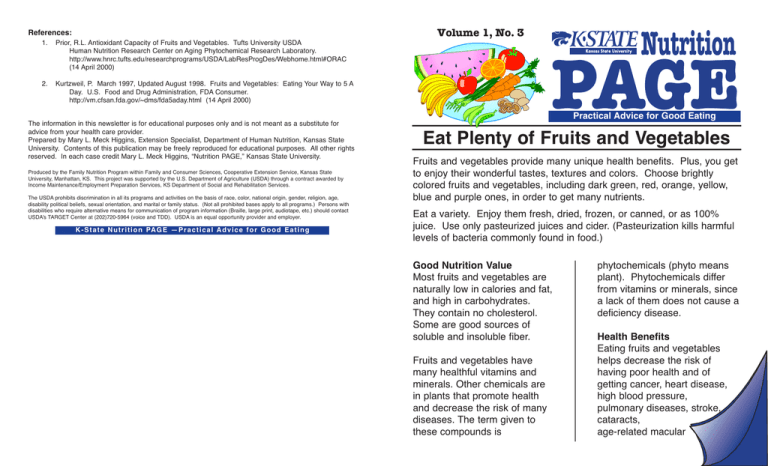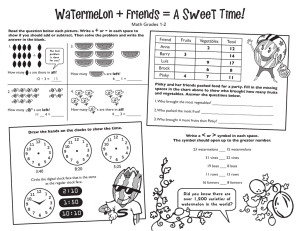
Volume 1, No. 3
References:
1.
Prior, R.L. Antioxidant Capacity of Fruits and Vegetables. Tufts University USDA
Human Nutrition Research Center on Aging Phytochemical Research Laboratory.
http://www.hnrc.tufts.edu/researchprograms/USDA/LabResProgDes/Webhome.html#ORAC
(14 April 2000)
2.
Kurtzweil, P. March 1997, Updated August 1998. Fruits and Vegetables: Eating Your Way to 5 A
Day. U.S. Food and Drug Administration, FDA Consumer.
http://vm.cfsan.fda.gov/~dms/fda5aday.html (14 April 2000)
Practical Advice for Good Eating
The information in this newsletter is for educational purposes only and is not meant as a substitute for
advice from your health care provider.
Prepared by Mary L. Meck Higgins, Extension Specialist, Department of Human Nutrition, Kansas State
University. Contents of this publication may be freely reproduced for educational purposes. All other rights
reserved. In each case credit Mary L. Meck Higgins, “Nutrition PAGE,” Kansas State University.
Produced by the Family Nutrition Program within Family and Consumer Sciences, Cooperative Extension Service, Kansas State
University, Manhattan, KS. This project was supported by the U.S. Department of Agriculture (USDA) through a contract awarded by
Income Maintenance/Employment Preparation Services, KS Department of Social and Rehabilitation Services.
The USDA prohibits discrimination in all its programs and activities on the basis of race, color, national origin, gender, religion, age,
disability political beliefs, sexual orientation, and marital or family status. (Not all prohibited bases apply to all programs.) Persons with
disabilities who require alternative means for communication of program information (Braille, large print, audiotape, etc.) should contact
USDA’s TARGET Center at (202)720-5964 (voice and TDD). USDA is an equal opportunity provider and employer.
K - S t a t e N u t r i t i o n PA G E — P r a c t i c a l A d v i c e f o r G o o d E a t i n g
Eat Plenty of Fruits and Vegetables
Fruits and vegetables provide many unique health benefits. Plus, you get
to enjoy their wonderful tastes, textures and colors. Choose brightly
colored fruits and vegetables, including dark green, red, orange, yellow,
blue and purple ones, in order to get many nutrients.
Eat a variety. Enjoy them fresh, dried, frozen, or canned, or as 100%
juice. Use only pasteurized juices and cider. (Pasteurization kills harmful
levels of bacteria commonly found in food.)
Good Nutrition Value
Most fruits and vegetables are
naturally low in calories and fat,
and high in carbohydrates.
They contain no cholesterol.
Some are good sources of
soluble and insoluble fiber.
Fruits and vegetables have
many healthful vitamins and
minerals. Other chemicals are
in plants that promote health
and decrease the risk of many
diseases. The term given to
these compounds is
phytochemicals (phyto means
plant). Phytochemicals differ
from vitamins or minerals, since
a lack of them does not cause a
deficiency disease.
Health Benefits
Eating fruits and vegetables
helps decrease the risk of
having poor health and of
getting cancer, heart disease,
high blood pressure,
pulmonary diseases, stroke,
cataracts,
age-related macular
degeneration of the eye,
constipation and diverticulosis.
Enjoy Five to Nine Servings
Daily
Eating fruits and vegetables
may help people live longer,
because the antioxidants these
foods contain help slow down
the aging process. Antioxidantrich fruits and vegetables help
protect cells from damage.
Eating fruits and vegetables
may also help protect mental
capacity in older adults.
• Most adults would benefit
from eating more fruits and
vegetables. Each day, try to
have three to five servings of
vegetables and two to four
servings of fruits.
Fruits and vegetables with high
levels of antioxidants include
prunes, raisins, blueberries,
blackberries, garlic, kale,
strawberries, spinach,
raspberries, Brussels sprouts,
plums, alfalfa sprouts, broccoli
florets, beets, oranges, red
grapes, red bell peppers,
cherries, kiwi fruit, pink
grapefruit, white grapes, onion,
corn, eggplant, cauliflower, and
peas.
• One serving is a medium
piece of fruit; 1 cup raw, leafy
vegetables; 1/2 cup fruit or
vegetables (raw, cooked,
canned, or frozen); 1/2 cup
cooked or canned dried peas or
beans; 3/4 cup 100% fruit or
vegetable juice; or 1/4 cup
dried fruit.
• Try choosing a vitamin Crich and a high fiber fruit or
vegetable each day, a vitamin
A-rich serving every other day,
and several servings of
cruciferous (cabbage-family)
vegetables each week.
• Even when eating a meal
away from home, order a
portion or two of fruits and
vegetables.
• When cooking vegetables,
remove them from heat just
when they are tender enough to
chew. You will retain more
nutrients if you do not overcook
them. If you have trouble
chewing, try chopping or
shredding your vegetables.
• The sodium content of most
canned vegetables is high. Buy
"no added salt" varieties if you
are trying to reduce your
sodium intake.
• The fiber content of fruits
and vegetables changes
depending on how they are
prepared. For example: a piece
of fresh fruit with skin has more
fiber than the same fruit without
skin, the same kind of fruit that
is cooked or canned has less
fiber, and its juice would have
the least fiber.
Reduce Waste and Expense
• Buy fresh fruits and
vegetables in season, in the
amount you will use in three
to six days. Buy both ripe and
not-so-ripe ones, so that they
will last a few days longer.
• Compare prices. Buy the
cheapest brand.
• Buy canned, frozen or dried
fruits and vegetables, and
100% juices, for later use, after
you’ve eaten the fresh ones.
• Store fruits and vegetables
where you will see them, so
you will remember to eat them.
Handle Produce Safely
• Rinse fresh fruits and
vegetables under running
water. Before you eat the
outer skin or peeling, you
may want to scrub it with a
clean dish brush. Do not use
soap.
• Throw away the outer
leaves of leafy vegetables,
such as lettuce and cabbage.
• Store cut, peeled fruits and
vegetables in the refrigerator.
• Avoid eating fruits and
vegetables that look
brownish, slimy or dried out.
• Wash your hands with
warm water and soap for at
least 20 seconds before and
after handling fresh fruits or
vegetables.




